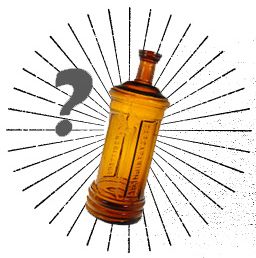There are several universal factors that affect the value of bottles, just like antiques and fine art. They are:
Condition: Bottles and glass objects that have survived 100 years or more in perfect condition are relatively few compared to all that have survived. Collectors tend to be very fussy about even the most minor flaws and have always paid more for perfect examples.
Color: It is quite common to find a bottle of a particular mold was made in a variety of colors. An identical bottle in cobalt blue can be worth 50-100 times what an aqua or clear example is worth. There are few generalizations that can be made of color, except perhaps that clear glass was mass-produced and is not in great demand. Ironically, before 1900, clear glass was considered the most refined and desirable color for tablewares.
Rarity: Simply stated, if only a handful of examples exist for a particular bottle, then generally it makes the bottle quite valuable. Common bottles made by companies that mass-produced thousands and thousands of identical examples have little value. However, there are many examples of common bottles (a common mold) that can be extremely valuable if found in a rare color. Also mold variants of common bottles can be much more desireable.
Demand: Bottles are worth what people are willing to pay for them, and prices follow the number of collectors seeking certain items and how deep their pockets are. In the past 2-3 years there seems to be a greatly renewed interest in collecting with many new collectors joining the hobby. While values of common bottles has risen some, the greatest increase in demand has been among the rarest and most important bottles.
Quality: No two bottles of the same mold look alike. Collectors often are looking for those examples which have certain characteristics. They are looking for the cleanest, most pristine examples that look like the day they were made. Bottles that have a especially pronounced handmade look with a rippled, shimmering glass surface (known as “whittling” as in carved wood), thick, uneven glass and irregular, uneven applied lips are especially desirable. These traits are best learned by examining many bottles and comparing them.

michelle reimel on said:
i have a bottle that has a extra lip on tha in side of it have any comment or what the heck is it thank you michelle